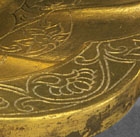J.J. Lally & Co., Oriental Art / New York City, New York
MenuPast Exhibition
Silver and Gold in Ancient China
March 16 – April 14, 2012
30.
A GILT-SILVER WINE CUP AND STAND
Northern Song Dynasty (A.D. 960-1127)
the flower-shaped wine cup with gently rounded and slightly flaring sides divided into ten petal-lobes, chased on the exterior with ten demi-florettes in a band below the lipped rim, the saucer-shaped stand also divided into ten lobes enclosed by a flat foliate rim of conforming outline with squared edge and raised on a high hollow ten-lobed foot, chased in the center of the stand with an undulating band of composite floral scroll, and the splayed edge of the foot chased with a border of pendant petal lappets enclosing demi-florettes, the gilded surface showing a soft luster and scattered dark tarnish, the patination and tarnish more concentrated on the underside of the cupstand where surface has not been as thoroughly cleaned.
Diameter of cupstand 5 1⁄8 inches (13 cm)
Diameter of cup 2 3⁄4 inches (7 cm)
Height overall 2 1⁄8 inches (5.4 cm)
A ten-lobed gold cupstand of closely related form excavated in 1958 from the ancient Xixia site at Gaoyoufang, Linhe county, Inner Mongolia and now in the collection of the Inner Mongolia Autonomous Region Museum, is illustrated in Wenwu, 1987, No. 11, p. 66, no. 3. The same cupstand is also illustrated in Zhongguo wenwu jinghua dacidian: jin yin yushi juan (The Compendium of Chinese Art: Gold, Silver, Jade and Stones), Hong Kong, 1994, p. 142, no. 156; and again by Watt in the catalogue of the special exhibition organized by the Metropolitan Museum of Art, The World of Khubilai Khan: Chinese Art in the Yuan Dynasty, New York, 2010, p. 7, fig. 5. The illustration of the cup and stand bears the caption “Xixia dynasty,” but, on the same page, Watt states that they are “…probably of Northern Song origin, as similar articles in lacquer and porcelain are known from Northern Song sites.”
The Xixia kingdom (A.D. 1038-1227) was founded by the Tanguts in a loose federation with other Tibet-related people who inhabited an area now designated as the Northwest Chinese provinces of Ningxia and Gansu. Jessica Rawson in The British Museum Book of Chinese Art, London, 1992, p. 302 says of the Xixia: “… they were much influenced by the Chinese. Mainly Buddhists, they adopted many Tang dynasty institutions.” Rawson goes on to provide a capsule history of the Xixia dynasty, writing: “They recognised the Liao as their overlords and united with them to block any Song advance northwards into their territory. The Song also paid the Xixia handsomely, from 1044 for several decades, in return for peace. From 1115 to 1119 the Song attacked the Xixia without much success, but the Xixia were finally defeated by the Mongols in their campaign of 1225-7 and were incorporated into the Mongol empire with the rest of China.”
北宋 鎏金花形銀盞及盞托
盞托徑 13 厘米 盞徑 7 厘米 通高 5.4 厘米
